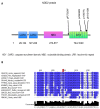A Novel Rare Missense Variation of the NOD2 Gene: Evidencesof Implication in Crohn's Disease
- PMID: 30769939
- PMCID: PMC6412783
- DOI: 10.3390/ijms20040835
A Novel Rare Missense Variation of the NOD2 Gene: Evidencesof Implication in Crohn's Disease
Abstract
The NOD2 gene, involved in innate immune responses to bacterial peptidoglycan, has been found to be closely associated with Crohn's Disease (CD), with an Odds Ratio ranging from 3⁻36. Families with three or more CD-affected members were related to a high frequency of NOD2 gene variations, such as R702W, G908R, and 1007fs, and were reported in the EPIMAD Registry. However, some rare CD multiplex families were described without identification of common NOD2 linked-to-disease variations. In order to identify new genetic variation(s) closely linked with CD, whole exome sequencing was performed on available subjects, comprising four patients in two generations affected with Crohn's disease without R702W and G908R variation and three unaffected related subjects. A rare and, not yet, reported missense variation of the NOD2 gene, N1010K, was detected and co-segregated across affected patients. In silico evaluation and modelling highlighted evidence for an adverse effect of the N1010K variation with regard to CD. Moreover, cumulative characterization of N1010K and 1007fs as a compound heterozygous state in two, more severe CD family members strongly suggests that N1010K could well be a new risk factor involved in Crohn's disease genetic susceptibility.
Keywords: Crohn’s disease; NOD2 gene; WES; variation.
Conflict of interest statement
The authors declare no conflict of interest.
Figures



Similar articles
-
A case-only study of gene-environment interaction between genetic susceptibility variants in NOD2 and cigarette smoking in Crohn's disease aetiology.BMC Med Genet. 2012 Mar 14;13:14. doi: 10.1186/1471-2350-13-14. BMC Med Genet. 2012. PMID: 22416979 Free PMC article.
-
Crohn's disease-associated NOD2 variants share a signaling defect in response to lipopolysaccharide and peptidoglycan.Gastroenterology. 2003 Jan;124(1):140-6. doi: 10.1053/gast.2003.50019. Gastroenterology. 2003. PMID: 12512038
-
CARD15/NOD2 gene variants are associated with familially occurring and complicated forms of Crohn's disease.Gut. 2003 Apr;52(4):558-62. doi: 10.1136/gut.52.4.558. Gut. 2003. PMID: 12631669 Free PMC article.
-
The NOD2-Smoking Interaction in Crohn's Disease is likely Specific to the 1007fs Mutation and may be Explained by Age at Diagnosis: A Meta-Analysis and Case-Only Study.EBioMedicine. 2017 Jul;21:188-196. doi: 10.1016/j.ebiom.2017.06.012. Epub 2017 Jun 16. EBioMedicine. 2017. PMID: 28668336 Free PMC article. Review.
-
Clinical applications of NOD2/CARD15 mutations in Crohn's disease.Acta Gastroenterol Latinoam. 2007 Mar;37(1):49-54. Acta Gastroenterol Latinoam. 2007. PMID: 17486745 Review.
Cited by
-
Ulcerative Colitis but Not Dextran Sodium Sulfate-Induced Colitis-Associated Microbiota Promotes Early Biomarkers of Colitis in Interleukin-10 -/- Mice.Gastro Hep Adv. 2025 Feb 4;4(6):100636. doi: 10.1016/j.gastha.2025.100636. eCollection 2025. Gastro Hep Adv. 2025. PMID: 40487274 Free PMC article.
-
GenePy - a score for estimating gene pathogenicity in individuals using next-generation sequencing data.BMC Bioinformatics. 2019 May 16;20(1):254. doi: 10.1186/s12859-019-2877-3. BMC Bioinformatics. 2019. PMID: 31096927 Free PMC article.
-
Inborn Errors in the LRR Domain of Nod2 and Their Potential Consequences on the Function of the Receptor.Cells. 2021 Aug 9;10(8):2031. doi: 10.3390/cells10082031. Cells. 2021. PMID: 34440800 Free PMC article. Review.
-
MiR-146a rs2910164 G > C polymorphism modulates Notch-1/IL-6 signaling during infection: a possible risk factor for Crohn's disease.Gut Pathog. 2020 Oct 15;12:48. doi: 10.1186/s13099-020-00387-0. eCollection 2020. Gut Pathog. 2020. PMID: 33072191 Free PMC article.
-
The Role of Autophagy in Inflammatory Bowel Disease.Front Physiol. 2021 Feb 3;12:621132. doi: 10.3389/fphys.2021.621132. eCollection 2021. Front Physiol. 2021. PMID: 33633585 Free PMC article. Review.
References
-
- Lesage S., Zouali H., Cézard J.-P., Colombel J.-F., Belaiche J., Almer S., Tysk C., O’Morain C., Gassull M., Binder V., et al. CARD15/NOD2 Mutational Analysis and Genotype-Phenotype Correlation in 612 Patients with Inflammatory Bowel Disease. Am. J. Hum. Genet. 2002;70:845–857. doi: 10.1086/339432. - DOI - PMC - PubMed
-
- Rivas M.A., Beaudoin M., Gardet A., Stevens C., Sharma Y., Zhang C.K., Boucher G., Ripke S., Ellinghaus D., Burtt N., et al. Deep resequencing of GWAS loci identifies independent rare variants associated with inflammatory bowel disease. Nat. Genet. 2011;43:1066–1073. doi: 10.1038/ng.952. - DOI - PMC - PubMed
-
- Franke A., McGovern D.P.B., Barrett J.C., Wang K., Radford-Smith G.L., Ahmad T., Lees C.W., Balschun T., Lee J., Roberts R., et al. Genome-wide meta-analysis increases to 71 the number of confirmed Crohn’s disease susceptibility loci. Nat. Genet. 2010;43:1118–1125. doi: 10.1038/ng.717. - DOI - PMC - PubMed

